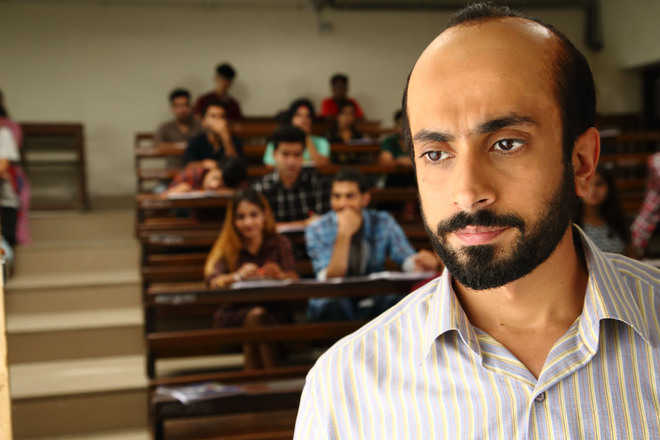
Ujda Chaman focus on early baldness
Dr Vikas Sharma
With two recent movies Ujda Chaman and Bala focussing on the problem of premature baldness, here are some facts about this dermatological condition that mostly affects men.
As in all other tissues in the human body, the hair follicle is susceptible to the ravages of age, stress and environment. A full head of hair contains approximately 100,000 hairs. A loss of up to 30 per cent hair of the number that was present during the peak of adolescence can occur as one reaches mid forties. Anxiety and cosmetic worry can build up when at least 50 per cent of the hairs have fallen out in a particular area.
Alopecia or hair loss is a common problem which may result into a lost sense of self confidence. People with alopecia not only face loss of hair but may also feel embarrassed to seek medical help, and may be frustrated by misinformation, misdiagnosis or poor treatment options.
During our life time, each hair follicle undergoes continuous cycles of growth (anagen), resorption (catagen), and rest (telogen). Growth cycles of hair are significant because when these go awry, hair loss happens.
When anyone experiences hair loss, major factors to consider include:
- When did the hair loss starts?
- Was the hair loss sudden in its onset or gradual? A sudden onset of hair loss is often an indication of disruption of the hair growth cycle (telogen effluvium) whereas gradual hair thinning typically occurs in male or female pattern hair loss.
- Where most hair loss is noticed?
- Pattern of hair loss: Determining whether the hair loss is patchy, diffused or patterned can help in proper diagnosis of the problem. Diffuse shedding typically occurs due to hair cycle changes. Patterned thinning involving mainly the frontal or top of the scalp is often indicative of a diagnosis of male or female pattern hair loss.
There are many reasons which cause hair loss. These can include abnormal levels of androgens (male hormones normally produced by both men and women), stress, illness, drugs, including chemotherapy drugs, blood thinners, and beta-adrenergic blockers used to control blood pressure and birth control pills. Burns, injuries and exposure to X-rays are some other factors. In most instances hair grows back normally if the problem is treated effectively. However, severe damage to the hair or scalp can sometimes cause permanent bald patches.
Medical conditions such as thyroid, lupus, diabetes, iron deficiency, eating disorders and anaemia can cause hair loss, but when the underlying condition is treated the hair grows back. A low-protein or severely calorie-restricted diet can also cause temporary hair loss.
Hair loss disorders
Autoimmune disorder alopecia areata is characterised by coin-shaped patches of hair loss over scalp though it can affect other hairy areas over the body as well. An early diagnosis and specific management can bring back the lost hair.
Male and female pattern hair loss is also known as androgenetic alopecia. However, some key differences are important to note. Pattern baldness due to genetic and hormonal factors tends to affect the frontal and vertex (top) portion of the scalp in men while in females it affects the central portion of the scalp, sparing the frontal hairline.
When to consult
- If you notice sudden changes in hair loss pattern, or excessive hair loss while washing, combing or oiling hair.
- If you notice thinning of hair and visibility of scalp skin, not visible earlier.
- If you notice textural changes in hair.
- If you notice small areas of partial or complete hair loss over scalp.
- If you notice excessive scaling and itching over scalp.
After complete hair analysis and investigative tests, if recommended by the doctor, treatment modalities can be worked out. If hair loss disorder is detected earlier and the severity is not much, the medical treatment options are effective. Some topical medicines used to treat androgenetic alopecia help in increasing blood supply to hair follicles, while oral medicines help by blocking conversion of testosterone to Dihydrotestosterone.
Another non-invasive treatment option, platelet rich plasma (PRP) contains a high concentration of thrombocytes. PRP carries various growth factors that stimulate cell proliferation and differentiation thus promoting hair growth. However, it requires many sittings, which are usually costly and results vary from person to person and may not meet expectations.
Hair transplant is surgical treatment option. Since the genetic and hormonal factors do not influence the hair follicles in the occipital region (back of scalp), therefore follicle units are extracted from the back of the scalp which becomes the donor site. These follicles are then surgically inserted into the bald area at front and vertex of scalp.
A 3000–3500 follicular-unit graft procedure typically requires 5-6 hours. However the advent of robotic arm assisted hair transplant has reduced the procedure time via couple of hours.
For seven to 10 days prior to this surgery, patient should refrain from using any medicines which might result in intra-operative bleeding and resultant poor grafting. Alcohol and smoking can also contribute to poor graft survival.
— The writer is a dermatologist, National Skin Hospital, Panchkula



























